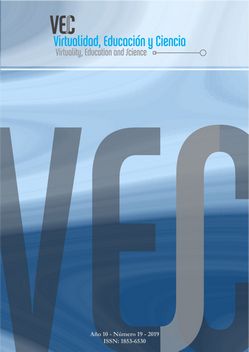Learning scenarios jointly designed by students and teachers in the university: the case of an Educational Technology subject
DOI:
https://doi.org/10.60020/1853-6530.v10.n19.24917Keywords:
university, digital technologies, co-designed learning scenariosAbstract
The aim of this study is to explore different dimensions of learning scenarios jointly designed by students and teachers in the subject Educational Technology of the Degree in Education of the National University of General Sarmiento. It is considered the course of the 2016 cycle, which was completely virtual. It is analyzed, in particular, the final work of the subject, which has been aimed at designing of a completely virtual teaching proposal in which digital technologies will be integrated, as well as developing the necessary learning resources (ie environment and digital materials) to implement the proposal. For this analysis, they are taken into account both the principles of the final work and the way in which the work was carried out. Our results dialogue with other research focused on co-design processes that have highlighted that this type of approach promotes significant learning and also opportunities to guide the teaching intervention.References
ADELL SEGURA, J., Y CASTAÑEDA QUINTERO, L. (2010) Los entornos Personales de Aprendizaje (PLEs): una nueva manera de entender el aprendizaje. En Roig Vila, R. & Fiorucci, M. (Eds) Claves para la investigación en innovación y calidad educativas. La integración de las Tecnologías de la Información y la Comunicación y la Interculturalidad en las aulas (pp. 19-30). Alcoy, España: Editorial Marfil.
ALA-MUTKA, K, BACIGALUPO, M, KLUZER, S., PASCU, C. PUNIE, Y. Y REDECKER, C. (2009). Learning 2.0: The Impact of Web 2.0. Innovations on Education and Training in Europe. Institute for Prospective Technological Studies. Joint Research Centre. European Commission. Recuperado de http://ipts.jrc.ec.europa.eu/publications/pub.cfm?id=2139 [3/12/2018].
ÁLVAREZ, G. Y BASSA, L. (2016). Estrategias didácticas para promover la escritura colaborativa mediada por tecnologías: hacia el desarrollo de dinámicas expertas en los grupos de trabajo. Exlibris núm. 5, 242-247. Recuperado de http://revistas.filo.uba.ar/index.php/exlibris/article/view/3022/968 [3/12/2018].
BEREITER, C. (2002). Education and mind in knowledge age. Hillsdale: N.J, Lawrence Erlbaum associates.
BEETHAM. H. Y SHARPE, R. (Eds.) (2007). Rethinking Pedagogy for the Digital Age. London: Routledge.
BREW, A. (2006). Research and teaching: beyond the divide. New York: Palgrave Macmillan.
CAMERON, L. y TANTI, M. (2011) Students as learning designers: Using social media to scalfold the experience. Learning Papers, 27. Recuperado de http://www.elearningeuropa.info/en/article/Students-aslearning-designers%3A--Using-social-media-to-scaffold-theexperience [3/12/2018].
CAMERON, L. Y GOTLIEB, C. (2009). Students Participating in the Learning Design Process Using LAMS, en L. Cameron y J. Dalziel (Eds.), Proceedings of the 4th International LAMS Conference 2009: Opening Up Learning Design., pp. 40-47. 3-4th December. 2009, Sydney: LAMS Foundation. Recuperado de http://lamsfoundation.org/lams2009sydney/CD/pdfs/03_Cameron.pdf [3/12/2018].
CONOLE, G., DYKE, M., OLIVER, M. Y SEALE, J. (2004) Mapping pedagogy and tools for effective learning design. Computers and Education, 43, pp. 17–33.
CONOLE, G., OLIVER, M., FALCONER, I., LITTLEJOHN, A., Y HARVEY, J. (2007). Designing for learning, en G. Conole y M. Oliver (Ed.), Contemporary Perspectives in E-learning Research: Themes, methods and impact on practice (Open and Distance Learning Series). Routledge Falmer.
CONOLE, G. (2008). Capturing Practice: The Role of Mediating Artefacts in Learning Design, en Lockyer, L.; Bennett, S.; Agostinho, S. y Harper, B. (Eds.). Handbook of Research on Learning Design and Learning Objects: Issues, Applications and Technologies. Hersey: IGI Global, pp. 187-207.
ELLIS, R. Y GOODYEAR, P. (2010). Students’ experiences of elearning in higher education. The ecology of sustainable innovation. New York y London: Routledge.
GONZÁLEZ, C. (2010). What do university teachers think eLearning is good for in their teaching? Studies in Higher Education, 35(1), pp. 61-78.
HERNÁNDEZ SAMPIERI, R., FERNÁNDEZ COLLADO, C. Y BAPTISTA LUCIO, P. (2006). Metodología de la Investigación. Ed. McGraw-Hill. México. 4ª Edición.
LANKSHEAR, C. Y KNOBEL, M. (2008). Nuevos alfabetismos. Madrid: Morata
LAURILLARD, D. (2006) E-learning in higher education, en P. Ashwin (Ed.), Chaning Higher Education. London: Routledge, 71-84.
GARCÍA, C.; YOT DOMÍNGUEZ, C.; SÁNCHEZ MORENO, M.; MURILLO ESTEPA, P.; MAYOR RUIZ, C. (2011). Diseñar el aprendizaje en la universidad: Identificación de patrones de actividades Profesorado. Revista de Currículum y Formación de Profesorado, vol. 15, núm. 2, pp. 181-198.
MASTERMAN, L. Y VOGEL, M. (2007). Practices and processes of design for learning. En Beetham. H. y Sharpe, r. (Eds.). Rethinking Pedagogy for the Digital Age. London: Routledge, pp. 52-63.
McANDREW, P. y GOODYEAR, P. (2007) Representing practitioner experiences through learning design and patterns. En Beetham, H. and Sharpe, R. (Eds.) Rethinking Pedagogy for a Digital Age. Routledge: London and New York.
REIGELUTH, C. (Ed.). (1999). Instructional design theories and models. Vol 2: a new paradigm of instructional theory. Mahwah NJ: Lawrence Erlbaum Associates.
ROGOFF, B. (1993). Aprendices del pensamiento. El desarrollo cognitivo en el contexto social. Barcelona: Paidós.
ROSCHELLE, J., PENUEL, W. R., Y SCHECHTMAN, N. (2006). Codesign of innovations with teachers: Definition and dynamics. Paper presented at the International Conference of the Learning Sciences, Bloomington, IN.
STRIJBOS, J. W., KIRSCHNER, P. A., Y MARTENS, R. L. (Eds.) (2004). What we know about CSCL: and implementing it in higher education. Boston, MA: Kluwer Academic Publishers.
TRIGWELL, K. Y SHALE, S. (2004) Student learning and the scholarship of university teaching. Studies in Higher Education, 29(4), pp. 523-53.
TRIGWELL, K.; PROSSER, M. Y WATERHOUSE, F. (1999) Relations between teachers’ approaches to teaching and students’ approaches to learning. Studies in Higher Education, 37(1), pp. 57-70.
VYGOTSKY, L. S. (1978). Mind in Society: The Development of Higher Psychological Processes. Cambridge: Harvard University Press.
Downloads
Published
Issue
Section
License
The generation of derivative works is allowed as long as it is not done for commercial purposes. The original work may not be used for commercial purposes.


